Causes of World War II

| World War II |
|---|
| Navigation |
|
|
| Timelines of World War II |
|---|
| Chronological |
| Prelude |
| By topic |
| By theatre |
The causes of
During the interwar period, deep anger arose in the Weimar Republic over the conditions of the 1919 Treaty of Versailles, which punished Germany for its role in World War I with heavy financial reparations and severe limitations on its military that were intended to prevent it from becoming a military power again. The demilitarisation of the Rhineland, the prohibition of German unification with Austria, and the loss of its overseas colonies as well as some 12% of its pre-war land area and population all provoked strong currents of revanchism in German politics.
During the worldwide economic crisis of the
At first, the aggressive moves met with only feeble and ineffectual policies of
Britain and France rejected diplomatic efforts to form a military alliance with the Soviet Union, and Hitler instead offered Stalin a better deal in the Molotov–Ribbentrop Pact of August 1939. An alliance formed by Germany, Italy, and Japan led to the establishment of the Axis powers.
Ultimate causes
Legacies of World War I
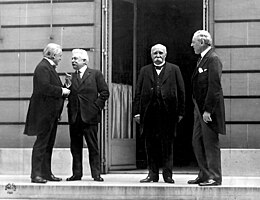
By the end of
The two main provisions of the French security agenda were war reparations from Germany in the form of money and coal and a detached German Rhineland. The German (Weimar Republic) government printed excess currency, which created inflation, to compensate for the lack of funds, and it borrowed money from the United States. Reparations from Germany were needed to stabilise the French economy.[5] France also demanded for Germany to give France its coal supply from the Ruhr to compensate for the destruction of French coal mines during the war. The French demanded an amount of coal that was a "technical impossibility" for the Germans to pay.[6] France also insisted on the demilitarisation of the German Rhineland in the hope of hindering any possibility of a future German attack and giving France a physical security barrier between itself and Germany.[7] The inordinate amount of reparations, coal payments and the principle of a demilitarised Rhineland were largely viewed by the Germans as insulting and unreasonable.
The resulting Treaty of Versailles brought a formal end to the war but was judged by governments on all sides of the conflict. It was neither lenient enough to appease Germany nor harsh enough to prevent it from becoming a dominant continental power again.[8] The German people largely viewed the treaty as placing the blame, or "war guilt", on Germany and Austria-Hungary and as punishing them for their "responsibility", rather than working out an agreement that would assure long-term peace. The treaty imposed harsh monetary reparations and requirements for demilitarisation and territorial dismemberment, caused mass ethnic resettlement and separated millions of ethnic Germans into neighbouring countries.
In the effort to pay war reparations to Britain and France, the
During the war,
The demilitarised Rhineland and the additional cutbacks on military also infuriated the Germans. Although France logically wanted the Rhineland to be a neutral zone, France had the power to make their desire happen, which merely exacerbated German resentment of the French. In addition, the Treaty of Versailles dissolved the German general staff, and possession of navy ships, aircraft, poison gas, tanks and heavy artillery was also made illegal.[7] The humiliation of being bossed around by the victor countries, especially France, and being stripped of their prized military made the Germans resent the Weimar Republic and idolise anyone who stood up to it.[12] Austria also found the treaty unjust, which encouraged Hitler's popularity.
The conditions generated bitter resentment towards the war's victors, who had promised the Germans that US President
Failure of the League of Nations
The
The League lacked an armed force of its own and so depended on member nations to enforce its resolutions, uphold economic sanctions that the League ordered or provide an army when needed for the League to use. However, individual governments were often very reluctant to do so. After numerous notable successes and some early failures in the 1920s, the League ultimately proved incapable of preventing aggression by the
Expansionism and militarism
Expansionism is the doctrine of expanding the territorial base or economic influence of a country, usually by means of military aggression. Militarism is the principle or policy of maintaining a strong military capability to use aggressively to expand national interests and/or values, with the view that military efficiency is the supreme ideal of a state.[17]
The Treaty of Versailles and the League of Nations had sought to stifle expansionist and militarist policies by all actors, but the conditions imposed by their creators imposed on the world's new geopolitical situation and the technological circumstances of the era only emboldened the re-emergence of those ideologies during the Interwar Period. By the early 1930s, militaristic and aggressive national ideologies prevailed in
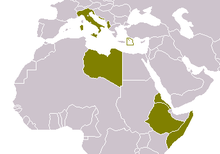
In Italy,
Under the Nazi regime, Germany began its own program of expansion that sought to restore its "rightful" boundaries. As a prelude toward its goals, the
During the Weimar Republic (1919–1933), the
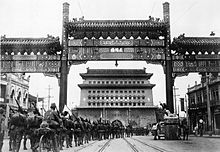
In Asia, the
For example, in 1931, the
Germans vs. Slavs
Twentieth-century events marked the culmination of a millennium-long process of intermingling between Germans and
Japan's seizure of resources and markets

Other than a few coal and iron deposits and a small oil field on
Japan's goal after 1931 was economic dominance of most of East Asia, often expressed in the
the new order in East Asia has appeared to include, among other things, depriving Americans of their long established rights in China, and to this the American people are opposed.... American rights and interests in China are being impaired or destroyed by the policies and actions of the Japanese authorities in China.[25]
In 1931, Japan invaded Manchuria and China proper. Under the guise of the Greater East Asia Co-Prosperity Sphere, with slogans such as "Asia for the Asians!", Japan sought to remove the Western powers' influence in China and replace it with Japanese domination.[26][27]
The ongoing conflict in China led to a deepening conflict with the US in which public opinion was alarmed by events such as the
With oil reserves that would last only a year and a half during peacetime and much less during wartime, the ABCD line left Japan two choices: comply with the US-led demand to pull out of China or seize the oilfields in the East Indies from the Netherlands. The Japanese government deemed it unacceptable to retreat from China.[28]
Mason-Overy debate: "Flight into War" theory
In the late 1980s, the British historian Richard Overy was involved in a historical dispute with Timothy Mason that played out mostly over the pages of the Past and Present journal over the reasons for the outbreak of the war in 1939. Mason had contended that a "flight into war" had been imposed on Hitler by a structural economic crisis, which confronted Hitler with the choice of making difficult economic decisions or aggression. Overy argued against Mason's thesis by maintaining that Germany was faced with economic problems in 1939, but the extent of those problems could not explain aggression against Poland and the reasons for the outbreak of war were the choices made by the Nazi leadership.
Mason had argued that the German working-class was always against the Nazi dictatorship; that in the overheated German economy of the late 1930s, German workers could force employers to grant higher wages by leaving for another firm and so grant the desired wage increases and that such a form of political resistance forced Hitler to go to war in 1939.[29] Thus, the outbreak of the war was caused by structural economic problems, a "flight into war" imposed by a domestic crisis.[29] The key aspects of the crisis were, according to Mason, a shaky economic recovery that was threatened by a rearmament program that overwhelmed the economy and in which the regime's nationalist bluster limited its options.[29] In that way, Mason articulated a Primat der Innenpolitik ("primacy of domestic politics") view of the war's origins by the concept of social imperialism.[30] Mason's Primat der Innenpolitik thesis was in marked contrast to the Primat der Außenpolitik ("primacy of foreign politics"), which is usually used to explain the war.[29] Mason thought German foreign policy was driven by domestic political considerations, and the launch the war in 1939 was best understood as a "barbaric variant of social imperialism".[31]
Mason argued, "Nazi Germany was always bent at some time upon a major war of expansion".[32] However, Mason argued that the timing of such a war was determined by domestic political pressures, especially as relating to a failing economy, and had nothing to do with what Hitler wanted.[32] Mason believed that from 1936 to 1941, the state of the German economy, not Hitler's "will" or "intentions", was the most important determinate on German foreign policy decisions.[33]
Mason argued that the Nazi leaders were so deeply haunted by the November 1918
Mason contended that when faced with the deep socio-economic crisis, the Nazi leadership had decided to embark upon a ruthless foreign policy of "smash and grab" to seize territory in Eastern Europe that could be pitilessly plundered to support the living standards in Germany.[35] Mason described German foreign policy as driven by an opportunistic "next victim" syndrome after the Anschluss in which the "promiscuity of aggressive intentions" was nurtured by every successful foreign policy move.[36] Mason's considered the decision to sign the Molotov–Ribbentrop Pact and to attack Poland despite the risk of a war against Britain and France to be the abandonment by Hitler of his foreign policy program outlined in Mein Kampf and to have been forced on him by his need to stop a collapsing German economy by seizing territory abroad to be plundered.[34]
For Overy, the problem with Mason's thesis was that it rested on the assumption that in a way that was not shown by the records, information was passed on to Hitler about Germany's economic problems.[37] Overy argued for a difference between economic pressures induced by the problems of the Four Year Plan and economic motives to seize raw materials, industry and foreign reserves of neighbouring states as a way of accelerating the plan.[38] Overy asserted that Mason downplayed the repressive German state's capacity to deal with domestic unhappiness.[37] Finally, Overy argued that there is considerable evidence that Germany felt that it could master the economic problems of rearmament. As one civil servant put it in January 1940, "we have already mastered so many difficulties in the past, that here too, if one or other raw material became extremely scarce, ways and means will always yet be found to get out of a fix".[39]
Proximate causes
Nazi dictatorship
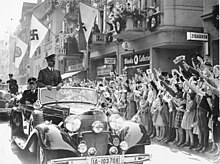
Hitler and his Nazis took full control of Germany in 1933–34 (
Hitler's diplomatic tactics were to make seemingly-reasonable demands and to threaten war if they were not met. After concessions were made, he accepted them and moved onto a new demand.[42] When opponents tried to appease him, he accepted the gains that were offered and went to the next target. That aggressive strategy worked as Germany pulled out of the League of Nations (1933), rejected the Versailles Treaty, began to rearm with the Anglo-German Naval Agreement (1935), won back the Saar (1935), re-militarized the Rhineland (1936), formed an alliance ("axis") with Mussolini's Italy (1936), sent massive military aid to Franco in the Spanish Civil War (1936–39), seized Austria (1938), took over Czechoslovakia after the British and French appeasement of the Munich Agreement of 1938, formed a peace pact with Stalin's Russia in August 1939 and finally invaded Poland in September 1939.[43]
Remilitarization of the Rhineland
In violation of the Treaty of Versailles and the spirit of the
Italian invasion of Abyssinia
Following the
Spanish Civil War
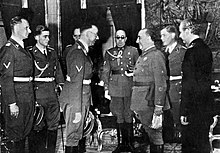
Between 1936 and 1939, Germany and Italy lent support to the
Spain negotiated with joining the Axis but remained neutral during World War II and did business with both sides. It also sent a volunteer unit to help the Germans against the Soviets. The Spanish Civil War was considered in the 1940s and 1950s to be a prelude to World War II, which was the case to some extent by changing it into an antifascist contest after 1941, but bore no resemblance to the war that started in 1939 and had no major role in causing it.[47][48]
Second Sino-Japanese War
In 1931, Japan took advantage of China's weakness in the
The invasion was launched by the bombing of many cities such as Shanghai, Nanjing and Guangzhou. The latest, which began on 22 and 23 September 1937, called forth widespread protests culminating in a resolution by the Far Eastern Advisory Committee of the League of Nations. The Imperial Japanese Army captured the Chinese capital city of Nanjing and committed war crimes in the Nanjing Massacre. The war tied down large numbers of Chinese soldiers and so Japan set up three different Chinese puppet states to enlist some Chinese support.[49]
Anschluss

The
The National Socialist Program included the idea in one of its points: "We demand the unification of all Germans in the Greater Germany on the basis of the people's right to self-determination."
The
The Austrian government resisted as long as possible but had no outside support and finally gave in to Hitler's fiery demands. No fighting occurred, most Austrians supported the annexation and Austria was fully absorbed as part of Germany. Outside powers did nothing, and Italy had little reason for continued opposition to Germany and, if anything, was drawn in closer to the Nazis.[51][52]
Munich Agreement
The Sudetenland was a predominantly-German region in Czechoslovakia along the border with Germany. It had more than three million ethnic Germans, who comprised almost a quarter of the country's population. In the Treaty of Versailles, the region was given to the Czechoslovakia against the wishes of most of the local population. The decision to disregard its right to self-determination was based on France's intent to weaken Germany. Much of Sudetenland was industrialised.[51]
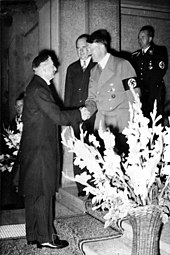
Czechoslovakia had a modern army of 38 divisions, backed by a well-noted armament industry (Škoda) and military alliances with France and the Soviet Union. However, its defensive strategy against Germany was based on the mountains of the Sudetenland.
Hitler pressed for the Sudetenland's incorporation into Germany and supported German separatist groups within the region. Alleged Czechoslovak brutality and persecution under Prague helped to stir up nationalist tendencies, as did the Nazi press. After the Anschluss, all German parties except for the German Social-Democratic Party merged with the Sudeten German Party (SdP). Paramilitary activity and extremist violence peaked during the period, and the Czechoslovak government declared martial law in parts of the Sudetenland to maintain order. That only complicated the situation, especially since Slovak nationalism was rising from suspicion towards Prague and encouragement by Germany. Citing the need to protect the Germans in Czechoslovakia, Germany requested the immediate annexation of the Sudetenland.
In the Munich Agreement on September 30, 1938, the British, French, and Italian prime ministers appeased Hitler by giving him what he wanted in the hope that it would be his last demand. The powers allowed Germany to move troops into the region and incorporate it into the Reich "for the sake of peace". In exchange, Hitler gave his word that Germany would make no further territorial claims in Europe.[53] Czechoslovakia was not allowed to participate in the conference. When the French and British negotiators informed the Czechoslovak representatives about the agreement and that if Czechoslovakia would not accept it, France and Britain would consider Czechoslovakia to be responsible for war and stay neutral, Czechoslovak President Edvard Beneš capitulated and Germany took the Sudetenland unopposed.[54]
Chamberlain's policies have been the subject of intense debate for more than 70 years by academics, politicians and diplomats. The historians' assessments have ranged from condemnation for allowing Hitler's Germany to grow too strong to the judgment that Germany was so strong that it might well win a war and so the postponement of a showdown was in the country's best interests.[55]
German occupation and Slovak independence
In March 1939, breaking the Munich Agreement, German troops invaded Prague, and with the Slovaks declaring independence, Czechoslovakia disappeared as a country. The entire ordeal ended the French and British policy of appeasement.
Italian invasion of Albania
After the German occupation of Czechoslovakia, Mussolini feared for Italy becoming a second-rate member of the Axis. Rome delivered
On April 7, 1939, Italian troops invaded Albania, which was occupied after a three-day campaign with minimal resistance offered by Albanian forces.
Soviet–Japanese border war
In 1939, the Japanese attacked west from Manchuria into the Mongolian People's Republic after the 1938 Battle of Lake Khasan. They were decisively beaten by Soviet units, under General Georgy Zhukov. After the battle, the Soviet Union and Japan were at peace until 1945. Japan looked south to expand its empire, which led to conflict with the United States over the Philippines and the control of shipping lanes to the Dutch East Indies. The Soviet Union focused on its western border but left 1 million to 1.5 million troops to guard its border with Japan.
Danzig crisis
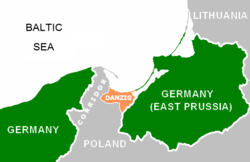
After the end of Czechoslovakia proved that Germany could not be trusted, Britain and France decided on a change of strategy. They decided any further unilateral German expansion would be met by force. The natural next target for German expansion was Poland, whose
After taking power, the Nazi government made efforts to establish friendly relations with Poland, which resulted in the signing of the ten-year
Polish alliance with the Entente
The
The
Interwar period
During the
The political alliance was signed there on February 19, 1921 by
The alliance was further extended by the Franco–Polish Warrant Agreement, signed on October 16, 1925 in Locarno, as part of the Locarno Treaties. The new treaty subscribed all previously-signed Polish–French agreements to the system of mutual pacts of the League of Nations.
The alliance was closely tied with the Franco-Czechoslovakian Alliance. France's alliances with Poland and Czechoslovakia were aimed at deterring Germany from the use of force to achieve a revision of the postwar settlement and ensuring that German forces would be confronted with significant combined strength of its neighbours. Although Czechoslovakia had a significant economy and industry and Poland had a strong army, the French–Polish–Czechoslovakian triangle never reached its full potential. Czechoslovakian foreign policy, under Edvard Beneš, avoided signing a formal alliance with Poland, which would force Czechoslovakia to take sides in Polish–German territorial disputes. Czechoslovakia's influence was weakened by the doubts of its allies as to the trustworthiness of its army, and Poland's influence was undermined by fighting between supporters and opponents of Józef Piłsudski. France's reluctance to invest in its allies' industry (especially Poland's), improve trade relations by buying their agricultural products and share military expertise further weakened the alliance.
In the 1930s, the alliance remained mostly inactive and its only effect was to keep the
1939
Finally, a new alliance started to be formed in 1939. The Kasprzycki–Gamelin Convention was signed May 19, 1939 in
The treaty was ratified by France on September 4, 1939, on the fourth day of German offensive on Poland.
However, France provided only token help to Poland during the war in the form of the Saar Offensive, which has often been considered an example of Western betrayal. However, the political convention was the basis of the recreation of the Polish Army in France.
Piotr Zychowicz quoted the memoirs of the
This section needs expansion. You can help by adding to it . (July 2014) |
In March 1939, Britain and France guaranteed the independence of Poland. Hitler's claims in the summer of 1939 on Danzig and the Polish Corridor provoked yet another international crisis. On August 25, Britain signed the Polish-British Common Defence Pact.
Molotov–Ribbentrop Pact

Nominally, the
In 1939, neither Germany nor the Soviet Union was ready to go to war with each other. The Soviet Union had lost territory to Poland in 1920. Although officially called a "non-aggression treaty," the pact included a secret protocol in which the independent countries of Finland, Estonia, Latvia, Lithuania, Poland and Romania were divided into
All of the mentioned countries were invaded, occupied, or forced to cede part of their territory by the Soviet Union, Germany or both. Finland and Romania maintained their independence, however being forced to cede parts of their territory.
The conflict between the Soviet Union and Finland had a great impact of assessing the former's military capabilities by Nazi Germany.
Declarations of war
Invasion of Poland
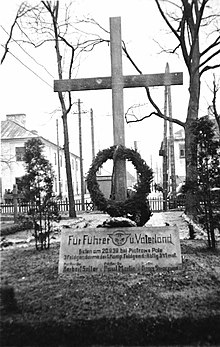
Between 1919 and 1939, Poland had pursued a policy of balancing between the Soviet Union and Nazi Germany and agreed to non-aggression pacts with both.[62] In early 1939, Germany demanded for Poland to join the Anti-Comintern Pact as a satellite state of Germany.[63] Poland, fearing a loss of independence, refused. Hitler admitted to his generals on 23 May 1939 that his reason for invading Poland was not Danzig: "Danzig is not the issue at stake. It is a matter of extending our living space in the East...".[64] To deter Hitler, Britain and France announced that an invasion would mean war and tried to convince the Soviet Union to join in this deterrence. The Soviets, however, gained control of the Baltic states and part of Poland by allying with Germany by the secret Molotov–Ribbentrop Pact in August 1939. London's attempt at deterrence failed, but Hitler did not expect a wider war. Germany invaded Poland on September 1, 1939, and rejected the British and French demands for it to withdraw, which resulted in both to declare war on September 3, 1939, in accordance with the defence treaties with Poland that they had signed and publicly announced.[65][66] However neither France nor Britain provided significant military aid to Poland except small operation known as Saar offensive. As of 1 September 1939 Poland was only partially mobilized, which was largely the result of pressure from the British and French ambassadors on the Polish government, fearing a repeat of the mobilization scenario of war from 1914. The Wehrmacht also had advantage in terms of the number of tanks and planes and the technical advancement of its equipment.
On September 17, 1939, the Red Army entered Poland from the east, and the Polish Command decided to abandon the defense of the so-called Romanian Bridgehead and evacuate of all its forces to neighboring countries. The last larger unit of Polish troops capitulated on October 6, 1939, near Kock, but some units went straight to partisan combat. Until the spring of 1940, the resistance of irregular units in the region of the Świętokrzyskie Mountains in central Poland lasted, but the struggle of these units resulted in enormous repressions against the civilian population of the region in which they operated.
Invasion of the Soviet Union
Germany attacked the Soviet Union in June 1941. Hitler believed that the Soviet Union could be defeated in a fast and relentless assault that capitalised on the Soviets' ill-prepared state and he hoped that his success there would bring Britain to the negotiating table, an event which would end the war altogether.
Attacks on Pearl Harbor, the Philippines, British Malaya, Singapore and Hong Kong
The US government and general public in general had been supportive of China, condemned European
Reacting to Japanese pressure on French authorities of
Taking advantage of the situation, Thailand launched the Franco-Thai War in October 1940. Japan stepped in as a mediator in the war in May 1941 and allowed its ally to occupy the bordering provinces in Cambodia and Laos. In July 1941, as Operation Barbarossa had effectively neutralised the Soviet threat, the faction of the Japanese military junta supporting the "Southern Strategy" pushed through the occupation of the rest of French Indochina.
The US reacted by seeking to bring the Japanese war effort to a complete halt by imposing a full embargo on all trade between the United States to Japan on August 18, 1941, and demanding a Japanese withdrawal of all troops from China and Indochina. Japan was dependent on the United States for 80% of its oil, which resulted in an economic and military crisis for Japan since it could not continue the war effort against China without access to petroleum and oil products.[71]
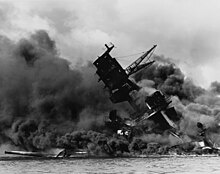
On 7 December 1941, without a declaration of war,[72] the Imperial Japanese Navy attacked Pearl Harbor with the aim of destroying the main American battle fleet at anchor. Meanwhile, other Japanese forces attacked the American-held Philippines and the British Empire in Malaya, Singapore, and Hong Kong. The following day, an official Japanese declaration of war on the United States and the British Empire was printed on the front page of all Japanese newspapers' evening editions.[73] International time differences caused the announcement to take place between midnight and 3 a.m. on 8 December in North America and at about 8 a.m. on 8 December in the United Kingdom.
Canada declared war on Japan on the evening of 7 December, and a
Four days later, the US was brought into the European war when on December 11, 1941, Nazi Germany and Fascist Italy declared war on the United States. Hitler chose to declare that the Tripartite Pact required Germany to follow Japan's declaration of war although American destroyers escorting convoys and German U-boats had been de facto at war in the Battle of the Atlantic. The declaration of war effectively ended US isolationist sentiment, and the country immediately reciprocated and so formally entered the war in Europe.[77]
See also
- Diplomatic history of World War II
- European Civil War
- European interwar economy
- International relations (1919–1939)
- Interwar period, worldwide
- Jewish war conspiracy theory: an antisemitic conspiracy theory promoted by the Nazis that falsely claims that the Jews had started World War II, used by the Nazis during the war to justify antisemitism, and after the war by Neo-Nazis to promote Nazism
- European foreign policy of the Chamberlain ministry
- Timeline of events preceding World War II
References
- ISBN 0300153554.
- ^ a b Paxton, p. 145
- ISBN 978-0826218711.
- ISBN 9780742536555.
- ^ a b Paxton, p. 153
- ^ Keynes, John Maynard (1920). "History of World War I". THE ECONOMIC CONSEQUENCES OF THE PEACE.
- ^ a b Paxton, p. 151
- ^ "The National Archives Learning Curve | The Great War | Making peace | Reaction to the Treaty of Versailles | Background". www.nationalarchives.gov.uk. Retrieved 2015-05-30.
- ^ Crossland, David (2010-09-29). "Germany Set to Make Final World War I Reparation Payment". ABC News. Retrieved 16 November 2011.
- ^ Paxton, p. 164
- ^ "Beer Hall Putsch". Holocaust Encyclopedia. Retrieved 16 November 2011.
- ^ Goebbels, Joseph (1941). "The New Year 1939/40". Die Zeit ohne Beispiel. Munich: Zentralverlag der NSDAP. pp. 229–239. Retrieved 16 January 2014.
- ^ Axelrod, Josh (11 August 2019). "A Century Later: The Treaty of Versailles and Its Rejection of Racial Equality". NPR.
- ISBN 978-0495898566.
- ISBN 9781135812423.
- ^ "History of the League of Nations". Retrieved 16 January 2014.
- ^ "the definition of militarism". Dictionary.com. Retrieved 2015-05-30.
- ISBN 9780739121306.
- ^ "Japanese history: Militarism and World War II". www.japan-guide.com. 9 June 2002. Retrieved 2015-05-30.
- ISBN 978-0-521-84515-1.
- ^ "World War 2 Causes". History Learning Site. Retrieved 6 March 2014.
- ^ Wimmer, Andreas (2012) Waves of War: Nationalism, State Formation, and Ethnic Exclusion in the Modern World.
- Burleigh, Michael(2001) The Third Reich: A New History
- ^ Hotta, Eri (2007) Pan-Asianism and Japan's war 1931–1945. Palgrave Macmillan
- ASIN B0006ER51M.
- S2CID 153621760.
- JSTOR 1790152.
- S2CID 152462148.
- ^ S2CID 221608764.
- ^ Kaillis, pp. 6–7
- ^ Kaillis, p. 7
- ^ a b Kaillis, p. 165
- ^ ISBN 0340760281
- ^ a b Kaillis, pp. 165–166
- ^ Kaillis, p. 166
- ^ Kaillis, p. 151
- ^ ISBN 0582304709.
- ISBN 0631207007.
- ISBN 0631207007.
- ^ Evans, Richard (2006) The Third Reich in Power
- Tooze, Adam(2008) The Wages of Destruction: The Making and Breaking of the Nazi Economy.
- ISBN 9781597970396.
- ISBN 0-226-88511-9.
- S2CID 145796434.
- ^ Baer, George W. (1976) Test Case: Italy, Ethiopia, and the League of Nations. Hoover Institution Press.
- ^ "Spanish Civil War (1936–1939) – History of Spain". donQuijote. Retrieved 2015-05-30.
- ISBN 978-0300130782.
- JSTOR 40105814.
- S2CID 161822140.
- ^ Gehl, Jürgen (1963) Austria, Germany, and the Anschluss, 1931–1938. Oxford University Press.
- ^ ISBN 1439132348
- ^ Wathen, Mary Antonia (1954) The policy of England and France toward the" Anschluss" of 1938. Catholic University of America Press.
- ^ Chamberlain's radio broadcast Archived 2007-06-07 at the Wayback Machine, 27 September 1938
- ^ Cole, Robert A. (2010). "Appeasing Hitler: The Munich Crisis of 1938: A Teaching and Learning Resource". New England Journal of History. 66 (2): 1–30.
- ^ Roberts, Andrew (November 1, 2019) "'Appeasement' Review: What Were They Thinking? Britain’s establishment coalesced around appeasement and bared its teeth at those who dared to oppose it." Wall Street Journal.
- ^ The German-Polish Crisis (March 27 – May 9, 1939)
- ISBN 978-0-415-28955-9.
- ISBN 978-0313260070.
- ^ Paul W. Doerr. 'Frigid but Unprovocative': British Policy towards the USSR from the Nazi-Soviet Pact to the Winter War, 1939. Journal of Contemporary History, Vol. 36, No. 3 (Jul., 2001), pp. 423–439
- ^ Keith Sword. "British Reactions to the Soviet Occupation of Eastern Poland in September 1939". The Slavonic and East European Review, Vol. 69, No. 1 (Jan., 1991), pp. 81–101.
- ^ Weinberg, Gerhard L. (1954). Germany and the Soviet Union. Studies in East European history. Brill Archive. pp. 49–50.
- ISBN 978-83-62453-00-9.
- ISBN 978-0300089158
- ^ "Bericht über eine Besprechung (Schmundt-Mitschrift)". "Danzig ist nicht das Objekt, um das es geht. Es handelt sich für uns um die Erweiterung des Lebensraumes im Osten und Sicherstellung der Ernährung, sowie der Lösung des Baltikum-Problems."
- ISBN 0674284003
- ]
- S2CID 162631136.
- ^ William L. Langer and S. E. Gleason, The undeclared war: 1940–1941. Vol. 2 (1953) pp. 9–21.
- JSTOR 2712474.
- ISBN 9780415356404
- ^ French, Howard W. (December 9, 1999). "Pearl Harbor Truly a Sneak Attack, Papers Show". The New York Times.
- ^ "Japan declares war, 1941 | Gilder Lehrman Institute of American History".
- ^ "Canada Declares War on Japan". Inter-Allied Review via ibiblio. December 15, 1941. Retrieved May 23, 2011.
- ^ Official Report, House of Commons, 8 December 1941, 5th series, vol. 376, cols. 1358–1359
- ^ "Declaration of War with Japan" Retrieved 2010-15-07
- United States declaration of war upon Germany (1941).
Cited sources
- Kallis, Aristotle (2000). Fascist Ideology. London: Routledge. ISBN 9780415216128.
- Paxton, Robert O. (2011). Europe in the Twentieth Century. United States: Wadsworth. ISBN 9781133171126.
Further reading
- Bell, P. M. H. The Origins of the Second World War in Europe (Routledge, 2014).
- Dowswell, Paul. The Causes of World War II (Heinemann, 2002).
- Kagan Robert. The Ghost at the Feast: America and the Collapse of World Order, 1900-1941 (Knopf, 2023); excerpt
- Morewood, Steve. "The origins of World War Two in Europe." in Themes in Modern European History, 1890-1945 (Routledge, 2008) pp. 291-330.
- Overy, Richard J. The Origins of the Second World War (Routledge, 2014) . a major scholarly study
- Tarling, Nicholas, and Margaret Lamb. From Versailles to Pearl Harbor: The Origins of the Second World War in Europe and Asia (Palgrave Macmillan, 2001) online.
- Watt, Donald Cameron. How War Came: The Immediate Origins of the Second World War, 1938–1939 (1989). online a major scholarly study; online review
- Weinberg, Gerhard L. A world at arms: A global history of World War II (Cambridge University Press, 2005).
External links
- France, Germany and the Struggle for the War-making Natural Resources of the Rhineland—Explains the long term conflict between Germany and France over the centuries, which was a contributing factor to the World Wars.
- The Way to Pearl Harbor: US vs Japan
- Czechoslovakia primary sources
